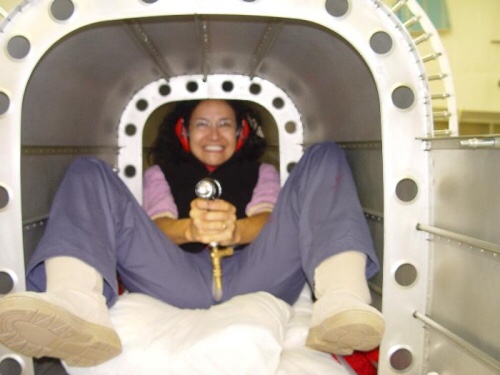that's a fairly fast build compared to some I see that are 5-6 years or more and still going at it... did you do a quick build kit?
Slow build. And I didn't quit my job to do it, either. I'm not setting any records. Van's reports a builder doing a slow-build RV-6 from before they prepunched the holes for you in 85 days. Today is day 318 since I uncrated the empennage kit. But for what it's worth, here are my tips to build fast, most of which I was told before I started and am simply highlighting here with details from my experience:
1. Build at home. This is by far the biggest one. If you have to change clothes, go to the hangar, get all your tools out, work, put the tools away, go home, and change clothes again, you'll rarely bother to work on it. Since my plane is in my unfinished, walk-out basement, which is not used for anything other than storing junk and building an airplane, I can just walk down the stairs, turn on the lights and air compressor, and work. No time overhead at all. if I have 5 minutes with nothing to do, I can spend all 5 of them building. If you work on it a little bit every day, you will be done faster than if you try to work on it all day but only one day a week, which turns into one day a month. And if you have small bits of progress every week by working a little bit almost every day, you will stay excited about it because of the tangible results. (My day job does not involve tangible results, so this hobby is really good to satisfy that need. If you build things for a living, your motivation to build something at home after work might be the opposite, like the cobbler's children who have no shoes.)
2. Get a helper. My friend who is helping me used to work at Quest and has over 100 of his babies (Kodiaks) flying out there in the wild. Having someone with that level of airplane building experience to help is great, but even if it were just another me (never worked with aluminum or set a rivet before in my life) it would save time to have a helper. You can build these planes almost entirely solo. However, the solo builders have to take time figuring out how to do some things that are trivial with a second set of hands.
3. If you prime, use Stewart Systems Ekoprime. It's water-based so you can spray it in your house or garage without fear of poisoning yourself or your pets. Plus it looks awesome. It doesn't stand up to acetone (ask how I know that...), but after it cures I have taken a piece of scrap (trim tab skin that I had messed up), stood on it with all my weight, and ground my boot into it for a few minutes. There was no noticeable damage to the primed skin. You can scratch it off with a bucking bar if you're not careful, but I'm not worried about the long-term resilience of the stuff at all.
I had previously included "don't prime" as a tip, but then I actually did the math from my build log spreadsheet. My logbook has 275 entries on 121 different days with a total of 274.3 hours. The items that mention priming were on 21 of those 121 days and 48.4 of those 274.3 hours, but most of those are "prep and prime" so the prep part (cutting, trimming, deburring) would have happened even if I didn't prime. Only 18% of my time is spent preparing and priming parts. The priming feels like a hassle every time my hand cramps up while scuffing the aluminum, but it really isn't slowing me down at all. Plus I can always prime parts solo on the days I am waiting for my helper to come over and buck some rivets.
4. Perfect is the enemy of good enough. Good example: I got a little run in the paint on my brake pedals. I could sand and repaint. I could strip and reprime and repaint. I could do a lot of things. But here's what I did instead: Nothing. I left them alone. I'm never going to be close enough to the brake pedals to see the minor surface imperfections. I'll mostly be stepping on them anyhow. There are at least 40,000 small battles (that's the best estimate of rivet count in the RV-14) and it would be stupid to lose the war by spending your whole life fighting a small battle that doesn't matter. The paint on the brake pedals is not the hill I am going to die on. I'm not trying to win any awards for perfection. I am just trying to build a safe, fun airplane. I'd rather spend my retirement (30+ years from now) flying an imperfect airplane than still building a perfect one.
5. Think about it all the time. I am constantly researching, thinking, planning, rethinking, etc. So when I walk down the stairs to the basement, I almost never have to waste a second trying to think of what to do next. I just know.


